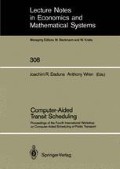Abstract
Bus-stops are often shared by several different services. Passengers may enjoy shorter waiting times I than if stops were specific to services because very often most of the services at the same bus-stop run on similar routes and will take the passengers close to their destinations. However, there may be times when after a long gap a few buses come at the same time. Such gaps are unpleasant for the passengers. Bus operators do not like this to happen either, as the buses would be unevenly loaded and this would cause other problems. Schedulers therefore try to co-ordinate the buses such that the intervals between bus arrivals on a common stretch of road are as evenly distributed as possible — at least theoretically in the timetables. Of course, any adjustment of timings will have to be justified cost-effectively, for example, the subsequent schedules should normally use the minimum number of buses. We shall call this kind of planning and scheduling exercise Headway Integration.
Departures at regular intervals (called headways) and extensively overlapping routes are characteristics of urban bus services in the U.K. and many other countries. For passenger convenience and satisfaction, and for operating efficiency, it is very desirable to achieve joint headways that are as regular as possible on overlapped stretches of routes. Currently available bus scheduling packages are not sufficient for this purpose. Most of them are good at minimising vehicle usage, but lack capability of retiming the trips necessary in co-ordinating joint headways.
This paper reports on an interactive heuristic approach that has led to the implementation of a computer system called HINT (standing for ’Headway Integration’) for co-ordinating joint headways. The approach centres on a set of system targets that reflect the current objectives such as what joint headways on which stretches of routes are desirable. The major role of the heuristics is to find quickly the best few solutions satisfying the system targets. The interactive utilities assist the scheduler to browse through the results yielded by the heuristics and analyse them in a systematic manner. More importantly, the scheduler can interactively exercise his expertise and local knowledge to override the default setup of system targets, and continually revise them in the light of further findings.
HINT has already been demonstrated to some bus operators in the U.K., who have shown much interest in it. Since HINT has been developed out of a research project on a specific computer installation, some conversion work would be needed before it can be generally available for commercial use.
Access this chapter
Tax calculation will be finalised at checkout
Purchases are for personal use only
Preview
Unable to display preview. Download preview PDF.
References
Bergmann, D.;_ Bodin, L. (Eds): Preprints: Proceedings of Workshop on Automated Techniques for Scheduling of Vehicle Operators for Urban Public Transportation Services Chicago, Illinois 1975, [BERGMANN, BODIN 75]
Bodin, L.D., Ball, M., Duguid, R., Mitchell, M.: The vehicle scheduling problem with interlining. Computer Scheduling of Public Transport 2. J.M. Rousseau, ed., Norht-Holland; Amsterdam 1985, 427–450 [BODIN et al 85]
Brandani, V.; Cataoli, G.; Orsi, G.; Toni, P.: Bus scheduling program development for A.TA.F. Florence. Computer Scheduling of Public Transport. A. Wren, ed., North-Holland; Amsterdam 1981, 71–84. [BRANDANI et al 81]
Ceder, A.: Methods for creating bus timetables. Transportation Research 21A (1986), 59–83 [CEDER 86]
Chriqui, C.; Robillard, P.: Common bus lines. Transportation Science 9 (1975), 165–175 [CHRIQUI, ROBILLARD 75]
Dexter, K.L.W.: Scheduling an urban railway. Computer Scheduling of Public Transport. A. Wren, ed.. North-Holland; Amsterdam 1981, 147–180 [DEXTER 81]
Kwan, R.S.K.: An interactive heuristic approach to headway integration. Proceedings of the 14th Annual Seminar on Public Transport Operations Research (Preprints), Leeds University, July 1982 [KWAN 82]
Luedtke, L.: RUCUS II: A review of the system capabilities. Computer Scheduling of Public Transport 2, J.M. Rousseau, ed., Amsterdam 1985, 61–116.[LUEDTKE 85]
Manington, P.D.; Proll, L.G.: Integration of Bus Schedules — A Progress Report. Dept. of Computer Studies, Leeds University, Report No. 60, ULORU-14, (Jan. 1975). [MANINGTON, PROLL 75]
Rousseau, J.M. (Ed.): Computer Scheduling of Public Transport 2. North-Holland; Amsterdam 1985 [ROUSSEAU 85]
Rousseau, J.M.; Blais, J.-Y.:HASTUS: An interactive system for buses and crew scheduling. J.) Computer Scheduling of Public Transport 2. J.M. Rousseau, ed., North-Holland; Amsterdam 1985, 45–60 [ROUSSEAU, BLAIS 85]
Smee, D.N.: A Plain Man’s Guide to VSPC and CABS Computer Development Section, Bus Schedules Office, London Transport, Revised Nov., 1983. [SMEE 83]
Smith, B.M.; Wren, A.: VAMPIRES and TASC: Two successfully applied bus scheduling programs. Computer Scheduling of Public Transport. A. Wren, ed., Amsterdam 1981, 97–124 [SMITH, WREN 81]
Williamson, R.H.: BUSMAN: The United Kingdom’s integrated approach to transit scheduling. Computer Scheduling of Public Transport 2. J.M. Rousseau, ed., North-Holland; Amsterdam 1985, 19–44. [WILLIAMSON 85]
Wren, A. (Ed.): Computer Scheduling of Public Transport: Urban Passenger Vehicle and Crew Scheduling. North-Holland; Amsterdam 1981 [WREN 81]
Wren, A.: General review of the use of computers in scheduling buses and their crews. Computer Scheduling of Public Transport. A. Wren, ed., North-Holland; Amsterdam 1981, 3–16. [WREN 81-1]
Author information
Authors and Affiliations
Editor information
Editors and Affiliations
Rights and permissions
Copyright information
© 1988 Springer-Verlag Berlin Heidelberg
About this paper
Cite this paper
Kwan, R.S.K. (1988). Co-ordination of Joint Headways. In: Daduna, J.R., Wren, A. (eds) Computer-Aided Transit Scheduling. Lecture Note in Economics Mathematical Systems, vol 308. Springer, Berlin, Heidelberg. https://doi.org/10.1007/978-3-642-85966-3_26
Download citation
DOI: https://doi.org/10.1007/978-3-642-85966-3_26
Publisher Name: Springer, Berlin, Heidelberg
Print ISBN: 978-3-540-19441-5
Online ISBN: 978-3-642-85966-3
eBook Packages: Springer Book Archive

